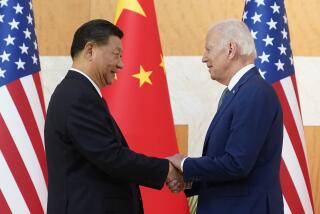Q&A: Learning Mandarin is really, really hard — even for many Chinese people
Mandarin Chinese is a notoriously difficult language to learn — a labyrinth of semantic tones, elaborate characters and obscure idiomatic phrases. And in China, a land of infinite linguistic diversity, the government has spent decades struggling to unify the country under that one language, not without some controversy.
David Moser, the author of “A Billion Voices: China’s Search for a Common Language,” who has lived in China for more than two decades, talks about the thorny politics of Mandarin Chinese, which is known in Chinese as Putonghua.
See more of our top stories on Facebook >>
How hard is it to learn Chinese, really?
There are aspects of Chinese that make it hard for foreigners to learn, and there are aspects that make it difficult for native Chinese. I think the one that gets the most press — and is in some sense the most controversial — is the Chinese characters. For alphabetic languages, there’s what they call a virtuous loop between the writing, speaking and listening — those three categories constitute one composite skill. But the problem with Chinese, and to some degree Japanese, is it breaks that loop. Speaking does not necessarily help your reading. Reading doesn’t necessarily help your writing. These become three different skills that have to be mastered in parallel, and separately.
Another thing: One of the first things that happens when you come to China is you learn that standard Mandarin — Putonghua — is only the prescribed, nationally mandated form of Chinese. When you get here, you find that your ears are confronted, if that’s a correct metaphor, with all kinds of different accents and varying degrees of regional dialects. These are very similar in a way to the different accents that you hear in English. But because of China’s linguistic diversity — it’s a much broader region, with a greater diversity of language groups — those differences are harder to get used to.
Your book is called “China’s Search for a Common Language.” Describe this search and why it’s significant.
[The dialect issue] is changing mainly because since the ’50s, the People’s Republic of China has mandated an official version of Chinese as the state language — the national lingua franca. Since this is very much a one-party state — a totalitarian state — policy tends to be mandated from the top down, and they have the enforcement wherewithal to make sure it’s carried out. So Putonghua is mandated in the media and in education, even in remote areas. And because several generations have grown up under that system, those regional dialects are disappearing. In the cases where they aren’t, some families are bilingual — they speak Putonghua and a dialect.
In the modern era, with more communications and travel within the country domestically, things like scientific meetings, political meetings, long-distance business deals and so forth are just much better facilitated, because people are more or less on the same page, speaking the same language. Believe it or not, that was not the case before 1949. It was the case that somebody from a remote region who traveled to Beijing to do business found he couldn’t communicate with the local people at all. There’s hardly this sort of domestic language barrier anymore, for business and communications.
But the department of education tells us that more than 400 million people in China cannot effectively speak the language — they understand it on media, and when visitors come — but they’re unable to communicate in Putonghua. So the effort is not over; it’s still a work in progress.
What’s being lost?
In some cases, not much is being lost. In some regional dialects that are very close to Mandarin — you know there are some dialects that you’d just call an accent — there’s not much loss there. But you also have what I call in the book “prestige dialects,” like the Shanghai dialect, and Cantonese, and arguably the Chongqing dialect. These not only have a lot of speakers — there are as many Cantonese speakers as all Italian speakers in the world — but a lot of traditional Chinese culture embedded in the language, especially Cantonese culture. There’s Cantonese opera, folk tales, regional storytelling forms, that can only really be carried out and appreciated in Cantonese. So the speakers of those dialects are understandably unhappy to see the dialect attenuated by this, and rulings [by China’s media regulators] that all media must be in Putonghua.
NEWSLETTER: Get the day’s top headlines from Times Editor Davan Maharaj >>
There have been dialect uprisings, as I call them. Some Cantonese speakers have literally rioted in the streets against policies that restrict Cantonese on the radio and TV. For these people, they believe it’s not just a loss of their regional accent, it’s a loss of local culture.
How has technology changed the situation?
I’d say there are two aspects. You’d have to separate the written and spoken language. TV and radio have leveled the playing field; they flatten out accents, so everyone is speaking basically the same dialect. That’s happened in the U.S.; it’s happened in China too.
But for the written language, there’s been a digital revolution, which has totally changed the way we write Chinese. There are a lot of aspects to talk about, but the long and short of it is, the new technology in our smartphones and computers means the writing of Chinese by hand is no longer an important, or I’d argue even a basic, skill anymore. That used to be one of the big stumbling blocks, learning to write these characters so you could communicate. Now we have these smartphones — you can talk into them, you can use [phonetic] entry. You really don’t have to bother yourself with the complexity of memorizing three or four thousand characters. That has been a huge revolution.
There’s one more aspect that I should mention: The side effect of all this, is that Chinese — native Chinese — are losing the ability to write their own language. My wife is Chinese, and she writes with her cellphone and computer. If I ask her to write me out something by hand, she throws up her hands and says, “Get me a computer; I can’t write anything by hand anymore.”
What are the trends now, vis a vis standardization?
One of the trends now is that the government is intensifying its insistence on the teaching of Putonghua. The implicit policy used to be that everyone had to learn Putonghua, but not everyone had to speak it in their local regions. The government wanted it to be a tool for universal communication, but the local dialects could continue to exist. And what’s happening now is the government is pushing that boundary, and encroaching onto the education system in places like Tibet and Xinjiang, increasingly insisting that classes be conducted in Putonghua. So the schoolkids in these areas are increasingly not exposed to their own language. That’s a big political controversy — a firestorm really — as a lot of ethnic Tibetans and Xinjiang people feel that the government is eroding their culture.
ALSO
A night of terror at the hands of the Taliban
Skyscrapers? Check. Parks? Check. People? Still needed.
How Xi Jinping’s crackdowns have squeezed the life out of Beijing’s indie rock scene
More to Read
Start your day right
Sign up for Essential California for news, features and recommendations from the L.A. Times and beyond in your inbox six days a week.
You may occasionally receive promotional content from the Los Angeles Times.






